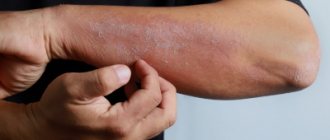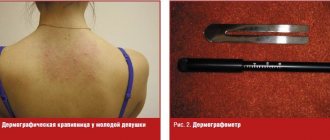Urticaria is a dermatitis that appears as itchy, swollen red spots on the skin. Allergies are a common cause of hives. Urticaria is characterized by rapid appearance and disappearance within a few hours. But for some people the disease appears again and again.
People prone to hives develop a symptom called angioedema or angioedema. Swelling and puffiness appears on the face - eyelids, lips, as well as ears, arms, legs or genitals. Sometimes angioedema develops into a life-threatening allergic reaction.
Contact your doctor immediately if you notice signs of hives, swelling, or any of the following symptoms:
- Labored breathing;·
- Feeling of squeezing in the throat;
- Nausea and vomiting;
- Cramps or stomach pain;
- Fainting.
Allergies are caused by:
- Medicines, such as antibiotics or aspirin;
- Foods: eggs, nuts, fish or shellfish;
- Something they have touched, such as plants, animal saliva, or latex;
- Insect bites.
If hives are caused by allergies, avoid contact with allergens.
Urticaria is also caused by:
- Infections;
- Cold air, contact with cold water on the skin;
- Changes in body temperature (for example, when you cool down after a hot shower or workout).
If hives last more than six weeks, you most likely do not have an allergy, but the disease is chronic. The causes of chronic urticaria are difficult and rare to identify.
If you are diagnosed with chronic hives, you may need to take medications every day to control the condition. Fortunately, chronic hives disappear over time.
Causes of urticaria
The disease occurs under the influence of histamine and some other substances secreted by special “mast” cells of the skin. Histamine increases vascular permeability, causing swelling, and acts on nerve endings, leading to a burning sensation and itching. The main causes of urticaria are associated with disturbances in the functioning of the immune system. She begins to react inadequately to ordinary stimuli that would not cause any symptoms in a healthy person. It can be:
- food products;
- infections;
- medicines;
- food colorings;
- preservatives;
- insect bites.
Often the cause of the disease remains unknown (idiopathic urticaria). This disease is not contagious, but the tendency to it is inherited. Hives may disappear with age. Doctors believe that nervous urticaria without the influence of other factors is extremely rare; rather, on the contrary, its presence causes stress and anxiety in a person.
How is urticaria treated?
—Hives usually go away within a few days or weeks, even if you are not treated. If you are experiencing hives for the first time, talk to your doctor about whether treatment is needed. If necessary, the first step is to find out what exactly caused the disease. In the future, you need to avoid contact with this substance, the allergen.
To relieve itching, start taking antihistamines. These are the same medications that people take for allergies.
If the hives are generalized or don't go away, your allergist may prescribe medications called steroids. Steroids are effective, but you should not take them for long as they can cause serious side effects. These are not the kind of steroids that some athletes take outside the rules. These steroids only relieve itching and reduce swelling.
Symptoms of urticaria
Urticaria is manifested by itching and burning of the skin accompanied by the appearance of blisters.
The rash can be the size of a penny or in the form of merging separate large foci of irregular shape. If urticaria lasts more than 3 months, it is called chronic. With giant urticaria, the deep-lying parts of the skin and subcutaneous tissue undergo swelling. Angioedema of Quincke, occurring on the mucous membranes, can cause dysfunction of various organs and systems. With swelling of the larynx, difficulty breathing may occur, up to asphyxia; if localized on the mucous membranes of other organs, dysuric phenomena, symptoms of acute gastroenteritis, and intestinal obstruction may occur. Angioedema lasts from several hours to several days and disappears without a trace. In case of food allergies or helminthic infestations, the swelling can take a recurrent course. With contact urticaria, which occurs from contact with ragweed, primrose, poison ivy (phytodermatitis), glandular contents of caterpillars, cosmetics, and other haptens in production conditions, the rash can appear acutely, quickly, or many hours later; when scratching, it spreads beyond the contact the named substances with the skin.
In childhood urticaria, the appearance of small blisters is noted against the background of exudative diathesis and hypersensitivity to a number of foods.
What is chronic urticaria?
-It is characterized by swelling, redness and itching of parts of the skin. Groups of spots remain on the skin for less than a day. Hives appear anywhere on the body. The medical term for urticaria is “urticaria.” "Chronic" means long-term. People with chronic hives experience it most days for six weeks or more. Chronic urticaria is different from urticaria, which occurs suddenly and lasts a short time. This form of the disease can be caused by an allergy or infection. Sometimes sudden hives mean a life-threatening allergic reaction has occurred. You may also experience other symptoms, such as trouble breathing or fainting.
Chronic hives that are not caused by allergies or infections are not life-threatening. But it causes severe itching and interferes with normal sleep. Chronic hives go away over time for most people, but for some it can last for years. There is no cure for chronic hives, but medications can help relieve symptoms.
Publications in the media
Urticaria is a disease manifested by a transient rash, the morphological element of which is a blister (urticaria), i.e. a clearly limited area of edema of the dermis. The color of the blister is red, the diameter is from several millimeters to several centimeters. Statistical data. Urticaria ranks third in the structure of allergic diseases after bronchial asthma and drug allergies. 15–25% of the population will experience urticaria or angioedema at least once during their lifetime.
Etiology • Allergens •• Food, incl. food additives •• Medicinal •• Venom of stinging insects •• Inhalation (pollen, etc.) and contact allergens • Substances that can activate mast cells without the participation of immunological mechanisms •• Acetylsalicylic acid and other NSAIDs •• Iodine-containing radiocontrast substances •• Plasma substitutes (p -ry dextran) •• Local anesthetics •• ACE inhibitors •• Codeine •• Tubocurarine •• Morphine •• Sodium thiopental • Transfusion reactions • Physical factors: heat, cold, insolation, pressure, etc. • Emotional stress • Diseases in which urticaria is one of the syndromes •• Infections - viral (infectious mononucleosis, hepatitis), helminthiases •• Collagenoses (SLE, rheumatoid arthritis) •• Serum sickness •• Cryoglobulinemia •• Mastocytosis •• Neoplastic processes • • Hyper- and hypothyroidism.
Pathogenesis • The appearance of skin elements is associated with the activation of mast cells and their release of mediators (histamine, Pg, leukotrienes), causing a local increase in vascular permeability • Mast cells are activated either through immunological mechanisms (IgE-mediated allergy, complement components - anaphylatoxins C3a and C5a), or directly with certain substances (so-called histamine liberators).
Pathomorphology. Edema and perivascular infiltration of the epidermis and upper dermis by lymphocytes, mast cells, eosinophils, neutrophils with compression of veins and lymphatic vessels.
Classification
• Depending on the stimulus that causes activation of mast cells, immunological and non-immunological forms of urticaria are distinguished •• Immunological urticaria ••• Anaphylactic type, based on an IgE-dependent mechanism caused by the production of reagin antibodies of the IgE class to specific allergens (drugs, food, helminths ) ••• Cytotoxic type - urticaria caused by cytotoxic antibodies occurs as a result of transfusion complications. IgG and IgM antibodies react with isoantigens on the donor's red blood cells, activating the complement system and cytolysis ••• Immunocomplex type. Urticaria appears as a result of the formation of immune complexes that settle on the vascular wall and activate the complement system. Anaphylatoxins and histamine are formed. Causes - administration of vaccines and serums (serum sickness, the clinical manifestation of which is, along with other symptoms, urticaria) •• Non-immunological urticaria ••• Anaphylactoid, associated with the use of histamine liberators (drugs, dextran, benzoates, foods - strawberries, shrimp) or consumption of foods containing histamine and other vasoactive amines (certain types of cheeses, tuna fish, smoked meats, sauerkraut, etc.) ••• Aspirin-dependent ••• Caused by exposure to physical factors (dermographic, temperature - cold, heat, cholinergic, solar, contact, vibration).
• Hereditary forms of urticaria: hereditary angioedema, impaired protoporphyrin metabolism, Schnitzler syndrome (urticaria, amyloidosis, deafness), hereditary cold urticaria, C3 inactivator deficiency.
• Other types of urticaria: idiopathic, pigmentary, infectious, paraneoblastic, endocrine, psychogenic.
• Based on the duration of the disease, acute urticaria (less than 6 weeks) and chronic urticaria (more than 6 weeks) are distinguished.
• In half of patients with chronic urticaria, delayed pressure urticaria is simultaneously observed.
Clinical forms. The nature of the clinical picture of skin lesions is determined by the peculiarity of the vascular network of the dermis (“shock organ”). The main morphological element is a blister, accompanied by itching and characterized by “volatility”, i.e. ability to disappear within a few hours or minutes.
• Acute urticaria •• Often caused by immune mechanisms (food, drug allergens, insect bites) or the action of histamine liberators •• Goes away after a few hours •• May occur in the form of a single episode: characterized by the sudden appearance of blisters and itching, which persist for up to 6 weeks. Individual elements of the rash last no more than 24 hours •• Damage to the respiratory tract and gastrointestinal tract in acute urticaria, in contrast to Quincke's edema, is rarely observed. •• A combination of acute urticaria and Quincke's edema is possible.
• Chronic urticaria •• Persists for >6 weeks •• Caused more often by non-immune mechanisms, incl. systemic diseases •• Often (about 70% of cases) the cause remains unclear.
• Cold urticaria - develops with exposure to cold •• Can be fatal with general cooling (cold urticaria with massive histamine release) •• A common cause is exposure to cold water, cold air. The reaction usually occurs within a few minutes after exposure to cold •• In severe cases, urticaria is accompanied by weakness, headache, dizziness, shortness of breath, and tachycardia. Abdominal pain and nausea may occur •• There is familial cold urticaria - a rare form of urticaria that is inherited in an autosomal dominant pattern •• Reflex cold urticaria - a generalized or local reaction to cold, similar to cholinergic urticaria. Sometimes it occurs only when the whole body cools down. A local reaction to cold is manifested by a rash that appears around the cooled area of the skin, while the skin that was in direct contact with the cold is not affected.
• Cholinergic (thermal) urticaria - small papules (5–10 mm) that occur after overheating, a bath, or a hot shower.
• Physical stress urticaria - provoked by physical activity; manifests itself in the form of cholinergic urticaria, vascular edema, wheezing, and arterial hypotension. Its development is often associated with the intake of allergenic foods.
• Dermographic (mechanical) urticaria - linear papules and redness of the skin as a result of mechanical irritation.
• Solar urticaria is a result of exposure to sunlight. There are several types, depending on the wavelength of light that induces the reactions. Most react to UV rays. Starts in a few minutes; goes away within 1–2 hours after insolation •• There are two types of solar urticaria ••• Type 1 - urticaria mediated by IgE to Ag present only in the blood serum of a patient with urticaria •• Type 2 - urticaria mediated by IgE to Ag present as both in the patient and in a healthy person •• With fixed solar urticaria, the rash appears in the same areas even with irradiation of the whole body.
• Pressure urticaria - occurs 4-6 hours after pressure on the skin (elastic stockings, shoes, etc.). There are two forms of pressure urticaria - immediate and delayed •• Immediate - blisters and erythema appear within a few minutes after pressure is applied to the skin (without rubbing or stretching). The rash is accompanied by a burning sensation and lasts 30 minutes, but no more than 2 hours •• Slow - dark, itchy and painful blisters appear on areas of the body subject to prolonged compression: after long periods of walking or sitting. The rash appears within 30 minutes to 9 hours after skin irritation and persists for about 36 hours. Malaise, chills, and headache are possible.
• Aquagenic urticaria is a rare form. Small papules appear after contact with water at any temperature. In some cases, only itching without urticarial rashes may appear (aquagenic itch). The reaction is associated with mast cell degranulation.
• Contact urticaria - occurs when the skin or mucous membrane comes into contact with certain substances. Characterized by blisters, itching, burning. The most common cause is latex. In severe cases, a complication in the form of anaphylactic shock is possible.
• Idiopathic urticaria - the cause is unclear.
Diagnostics • For reactions to food or drugs - provocative tests with suspected allergens after an elimination diet • Inhalation allergens - skin tests, radioallergosorbent test (RAST) • Idiopathic, lasting more than 6 weeks - exclusion of systemic diseases (skin biopsy, ESR determination, urinalysis , ANAT, etc.) • Provocative tests •• Cold urticaria - cold test: a piece of ice is placed on the skin for 5 minutes; observe the reaction for 10–15 minutes •• Cholinergic or exercise-induced urticaria: exercise test, skin test with methacholine (local reaction to intradermal injection of 0.1 mg in 0.9% sodium chloride solution) •• Solar - insolation of a certain wavelength is carried out •• Delayed as a result of compression: a bag of sand of 2-4 kg is applied for 3 hours •• Aquagenic - tap water of various temperatures is used •• Infectious - bacteriological examination of a smear from the pharynx, titer of antistreptolysins, CRP, analysis stool (for parasites), liver function tests, mononucleosis test •• Autoimmune - ANAT, complement, cryoglobulins, serum protein electrophoresis.
Differential diagnosis • Erythema multiforme • Mastocytosis • Bullous pemphigoid (urticaria stage) • Herpes • Dermatitis herpetiformis.
Treatment • Drugs of choice - antihistamines •• For acute urticaria, first generation drugs are preferable (the effect of second generation drugs mainly manifests itself at a later stage) ••• For adults and children over 6 years old - diphenhydramine 25-50 mg every 6 hours •• • Children under 6 years old - diphenhydramine 5 mg/kg/day •• For chronic urticaria ••• Loratadine 10 mg 1 time / day ••• Cetirizine 0.01 g 1 time / day (evening) or 0.005 g 2 times /day (morning and evening) ••• Cyproheptadine 4–8 mg every 4–8 hours (children - 0.25–0.5 mg/kg/day every 6–8 hours) ••• Fexofenadine-180, once per day ••• Ebastine for adults 10–20 mg 1 time / day, for children in the form of syrup • Alternative drugs •• For chronic urticaria - histamine H2 receptor blockers (cimetidine, ranitidine) in addition to H1 receptor blockers • In severe, resistant in cases of therapy - GC (for example, prednisolone up to 40 mg daily, followed by a gradual dose reduction).
A complication is a severe systemic allergic reaction (bronchospasm, anaphylaxis).
Course and prognosis. Improvement in less than 72 hours in 70% of patients (chronic form - improvement in 30% of patients).
ICD-10 • L50 Urticaria
Notes. The mechanisms of urticaria and Quincke's edema are the same - a localized anaphylactic reaction causes vasodilation, increased vascular permeability of the dermis (urticaria) or subcutaneous tissues (Quincke's edema).
What are the symptoms of chronic urticaria?
People with chronic hives have swollen, red areas on the skin. These areas are often round and pale in the middle. The spots itch, especially at night. Urticaria "capricious lady" - quickly begins and goes away.
Here are some effects on a person that lead to worsening symptoms. These include:
- Overheating in a hot shower or hot, humid weather;
- Tight clothing, tight belts or belts;
- Medicines called non-steroidal anti-inflammatory drugs. This is a group of medications that include aspirin, ibuprofen, and naproxen;
- Alcohol;
- Stress;
- Some spicy foods;
- Cold;
- Insufficient sleep.
Patients with chronic urticaria suffer from angioedema. This process is characterized by massive subcutaneous swelling of the lips, cheeks, eyelids, arms, legs, or genitals (Fig. 2).
How is chronic urticaria treated?
Chronic urticaria usually goes away with time. Most patients get better within a year, but the pain lasts for a year or two. To relieve symptoms, doctors prescribe medications. Patients have to take two or three medications daily to control the course of the disease.
Medicines used for chronic urticaria:
- Antihistamines relieve itching and reduce swelling and size of spots;
- Steroid tablets - also help fight itching and swelling.
If these medications do not help, tell your doctor. Over-the-counter creams or lotions rarely help.
How long does hives last?
Typically, the duration of urticaria ranges from a few days to several years. Everything is individual, depending on the type of skin disease. Mild urticaria disappears quickly, usually in young children, when a food allergen hits them. As soon as it is eliminated from food, the rash disappears literally before our eyes. In adults, urticaria occurs in a more acute form with a longer course and manifestation of symptoms. Blisters can last up to a month. This is due to the more complex diagnosis of urticaria. But as soon as the cause is found out and the harmful factor is eliminated, the patient gets better. However, if symptoms appear after one to two months, the urticaria is considered to have become chronic. This type of urticaria can last up to several years. It all depends on the individual characteristics of the human body and lifestyle.
How can I help myself?
Try to avoid taking non-steroidal anti-inflammatory drugs and alcohol. Avoid taking excessively hot showers and wearing tight-fitting clothing. Provide yourself with adequate sleep.
Chronic hives are not caused by food allergies, but some people find that the condition gets worse after eating certain foods. If so, try to avoid these foods. But if the list of such products turns out to be too long, tell your doctor about it.
What is inducible urticaria?
-Symptoms of inducible urticaria are red, itchy spots on the skin (Fig. 1). Inducible urticaria forms in response to physical irritation. For example, exposure to excess heat, cold or pressure. Inducible urticaria is known as “physical” urticaria.
The causes of induced urticaria are known:
- Combing
. As a result of scratching, red, swollen stripes or scratches develop on the skin (Fig. 3). Doctors call this "dermatographism." This type is characterized by the fact that the skin reacts to the action of nails when scratching in areas of itching. - Cold
. In people who are sensitive to cold, hives appear after the skin begins to warm up again after cooling. - Increased body temperature or sweating
. People who are sensitive to heat or sweat develop many tiny spots when their skin cools after a hot shower or exercise. - Vibration.
Signs of hives appear on those parts of the body that touch vibrating objects. Skin irritation occurs on the palms. For example, among motorists when their palm comes into contact with the steering wheel of a car, or among a lawn mower. - Intense pressure.
Redness and swelling appear in the part of the body where pressure was applied. For example, after carrying a heavy bag, the palm suddenly swells and swells. Or the soles of your feet swell after a hike. - Physical exercise.
Hives that appear during exercise may be a sign of a dangerous problem called anaphylaxis. If symptoms appear after exercise, they are most likely caused by changes in body temperature or sweating. - Sunlight or water
. Hives caused by sunlight or water are rare.
Inducible urticaria is considered a chronic type of urticaria.
Diagnosis of urticaria
Urticaria is diagnosed by a specialist (for example, a dermatologist): this is usually done during an examination based on the characteristic appearance of the rash. If the urticaria is acute, the patient, as a rule, does not need additional research: this type of disease usually goes away quickly on its own and does not subsequently return. If urticaria is chronic, it is important to determine its immediate cause in order to select the correct treatment. Laboratory diagnostics are used for this.
Laboratory tests necessary to diagnose urticaria:
- Clinical blood test;
- ESR;
- General urine analysis
- Fecal analysis for the presence of helminth eggs;
- Circulating immune complexes (CIC);
- Antibodies to double-stranded DNA;
- Antinuclear factor;
- C3 and C4 complement components;
- Culture of flora to determine sensitivity to antibiotics (various locations);
- Intestinal dysbiosis;
- AST;
- ALT;
- Serum urea and creatinine;
- Total bilirubin;
- T3 free;
- T4 free;
- AT-TG;
- AT- TPO;
- Total immunoglobulins E in serum.
Additional tests needed to diagnose urticaria:
- Ultrasound of the thyroid gland (code 21331 and code 21344 for children) and ultrasound of the abdominal organs (code 21313 or code 21314);
- Skin biopsy;
In some cases, diagnosing urticaria may require consultation with a dermatovenerologist, gynecologist and other specialists.
Should I see a doctor?
-Consult your doctor if you don't know what causes hives or don't know how to avoid exposure to an allergen.
Some types of induced urticaria are associated with anaphylaxis. For example, if you have cold-induced hives, you may develop anaphylaxis if you swim in very cold water. Another example is exercise-induced anaphylaxis. If you have exercise-responsive hives, it is important to stop and rest immediately if you notice red spots appearing. It is dangerous to continue training.
Symptoms of anaphylaxis are as follows:
- Difficulty breathing, wheezing, whistling sound when breathing.
- swelling of the face, eyelids, ears, mouth, hands, or feet;
- Abdominal cramps, nausea, vomiting, diarrhea;
- Feeling dizzy or faint.






